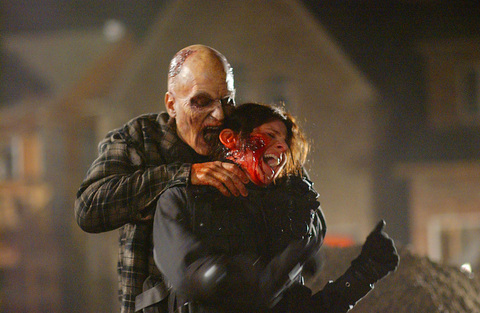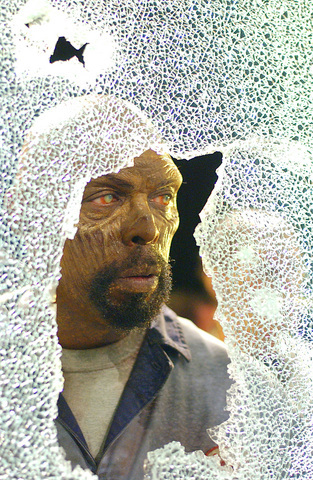George Romero's Land of the Dead, an excellent freakout of a movie, the living no longer have the advantage or our full sympathies. The fourth installment of Romero's vaunted zombie cycle (which began with his 1968 masterpiece, Night of the Living Dead), the new film is also the latest chapter in what increasingly seems like an extended riff on Dante's Inferno.
In the earlier Dead films, Romero guided us through circles of hell that, despite the flesh-eating ghouls, looked a lot like the exurban world outside our windows. With this new movie, we jump straight to the ninth circle, where Satan is a guy in a suit and tie who feasts on the misery of others, much as the dead feast on the living.
It's a sign of both Romero's waggish humor and control as a director that the guy in the suit and tie is played by the cult-movie icon Dennis Hopper, an often unrestrained performer who here is right on the money. Hopper plays Kaufman, the absolute ruler of a haven called Fiddler's Green, a tower of steel and glass at the center of a city with more than a passing resemblance to Manhattan. The tower, which appears to have been modeled on a Vegas hotel, complete with the usual feedlots, luxury stores and glassy-eyed shoppers, rises above the devastated metropolis like a threat and a promise. Outside its locked doors, amid atmospheric squalor, the huddling masses distract themselves with bread and circuses, while one man agitates for revolution.

PHOTOS COURTESY OF UNIVERSAL
Although they've always had a strong political subtext, Romero's zombie movies, which also include Dawn of the Dead (1978) and Day of the Dead (1985), have emphasized praxis over philosophy. To that end, the living hero of this film isn't the agitator, but a no-nonsense tough, Riley, played by the fine young Australian actor Simon Baker. Best known for the television show The Guardian, he has done exceptional work in both LA Confidential and Ride With the Devil, and in this film he holds the center with an attractive lack of fuss. His character is one of those burned-out warriors who says he wants to pack it in, only to be coerced back into action.
There aren't a lot of people in Land of the Dead whom the director likes as much as he does Riley, or for that matter, his zombie alter ego, Big Daddy (Eugene Clark). We meet Riley and Big Daddy after an attention-seeking credit sequence that recaps the zombie situation to date ("They kill for one reason. They kill for food.") and brings us straight to "Today." Here, in a wasteland called Uniontown, next to a diner sign emblazoned with the word "EATS," Riley and his sidekick, Charlie (Robert Joy), watch as Big Daddy, dressed in a gas-station attendant's uniform, tries to go through the work motions. Riley is struck by the zombie's commitment to its old rituals; but what gets his attention is that this itinerant corpse seems to be communicating with other zombies.
A pioneer in the slow-zombie movement (think of him as the Alice Waters of contemporary horror), Romero has not joined the recent fad for zippy corpses, as seen in both 28 Days Later and the remake of Dawn of the Dead. Romero's monsters still move at a relatively lethargic pace, dragging their dead weight as if they were made of lead, not putrefying flesh. What has changed since corpses roamed the cemetery in Night of the Living Dead crudely pockmarked with sores and dripping movie blood is the special-effects makeup, which in the new film is alternately frightfully real and obscenely beautiful. Here, Romero, whose striking parking-lot exteriors in Dawn of the Dead looked like they were designed by Ed Ruscha, creates gruesome demons right out of Hieronymous Bosch and Francisco Goya.

The story more or less takes the shape of an extended chase scene, in which the living and the zombies alternate between their roles as hunters and hunted. Riley, who's anxious to split for Canada (where the film was actually shot), to find a land without borders and zombies, works salvaging supplies from outside the city. Inside an armored vehicle ordained "Dead Reckoning," he and his crew, whose numbers include Cholo (an exceptionally good John Leguizamo), search the zombie-infested badlands for food and medical supplies. For Cholo and some of the others, there's much fun to be had popping wheelies on motorcycles while blowing holes through the zombies, even if the ghouls, still dressed in the clothes in which they died -- a cheerleader's outfit, a butcher's apron -- look uncomfortably human.
Neither fully alive nor dead, zombies exist between the margins, in a twilight state that makes them among the most unsettling of all man-made creatures. That's the essential paradox of all zombie movies, but it's a paradox that has taken on increasing complexity in Romero's zombie quartet. In Night of the Living Dead, the zombies were more or less indistinguishable rotting-meat puppets. Like animals, they were also beyond good and evil, eating simply because they were hungry. (And zombies, of course, are always hungry.) This first film centers on a cluster of people holed up in a farmhouse surrounded by the dead. The hero is a black man who tries to save everyone only to end up dead, shot by a posse that, as Romero makes clear in the devastating finale, is little more than a lynch mob.
With each of Romero's zombie movies, the walking dead have grown progressively more human while the living have slowly lost touch with their humanity. One thing that has always distinguished Romero's films, not only from the horror-genre pack but from so many action flicks, is that the director knows killing is killing. The chilling cackling of the posse at the end of Night of the Living Dead reverberates through the bombed-out landscapes in Land of the Dead from the start, as one zombie after another bites the dust. Romero can make you jump out of your seat with the best of them, but the greatest shock here may be the transformation of a black zombie into a righteous revolutionary leader.
With Revenge of the Sith and Batman Begins, Land of the Dead makes the third studio release of the summer season to present an allegory, either naked or not, of our contemporary political landscape. Whatever else you think about these films, whether you believe them to be sincere or cynical, authentic expressions of defiance or just empty posturing, it is rather remarkable that these so-called popcorn movies have gone where few US films dare to go.

May 26 to June 1 When the Qing Dynasty first took control over many parts of Taiwan in 1684, it roughly continued the Kingdom of Tungning’s administrative borders (see below), setting up one prefecture and three counties. The actual area of control covered today’s Chiayi, Tainan and Kaohsiung. The administrative center was in Taiwan Prefecture, in today’s Tainan. But as Han settlement expanded and due to rebellions and other international incidents, the administrative units became more complex. By the time Taiwan became a province of the Qing in 1887, there were three prefectures, eleven counties, three subprefectures and one directly-administered prefecture, with

It’s an enormous dome of colorful glass, something between the Sistine Chapel and a Marc Chagall fresco. And yet, it’s just a subway station. Formosa Boulevard is the heart of Kaohsiung’s mass transit system. In metro terms, it’s modest: the only transfer station in a network with just two lines. But it’s a landmark nonetheless: a civic space that serves as much more than a point of transit. On a hot Sunday, the corridors and vast halls are filled with a market selling everything from second-hand clothes to toys and house decorations. It’s just one of the many events the station hosts,

Among Thailand’s Chinese Nationalist Party (KMT) villages, a certain rivalry exists between Arunothai, the largest of these villages, and Mae Salong, which is currently the most prosperous. Historically, the rivalry stems from a split in KMT military factions in the early 1960s, which divided command and opium territories after Chiang Kai-shek (蔣介石) cut off open support in 1961 due to international pressure (see part two, “The KMT opium lords of the Golden Triangle,” on May 20). But today this rivalry manifests as a different kind of split, with Arunothai leading a pro-China faction and Mae Salong staunchly aligned to Taiwan.

Two moves show Taichung Mayor Lu Shiow-yen (盧秀燕) is gunning for Chinese Nationalist Party (KMT) party chair and the 2028 presidential election. Technically, these are not yet “officially” official, but by the rules of Taiwan politics, she is now on the dance floor. Earlier this month Lu confirmed in an interview in Japan’s Nikkei that she was considering running for KMT chair. This is not new news, but according to reports from her camp she previously was still considering the case for and against running. By choosing a respected, international news outlet, she declared it to the world. While the outside world